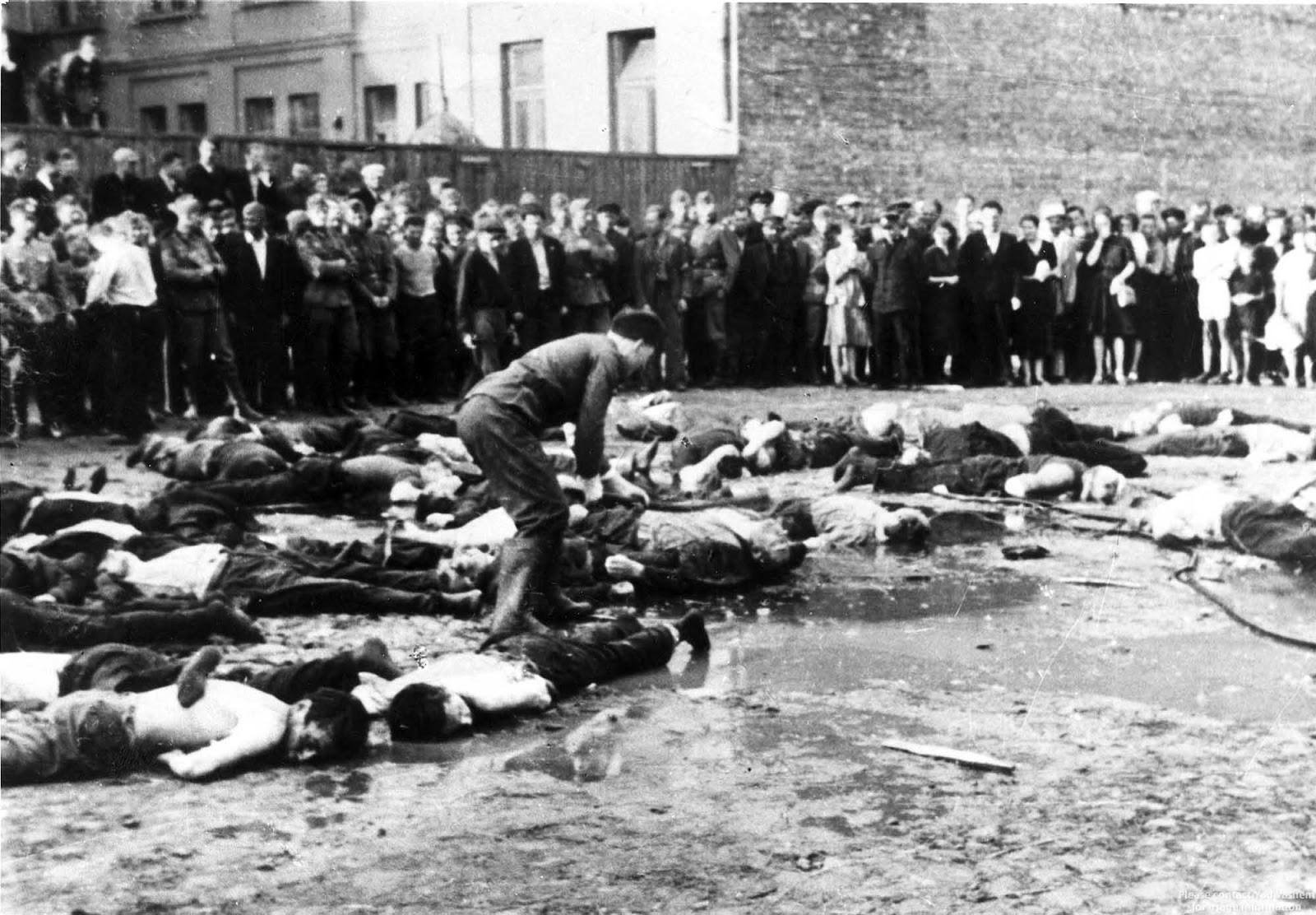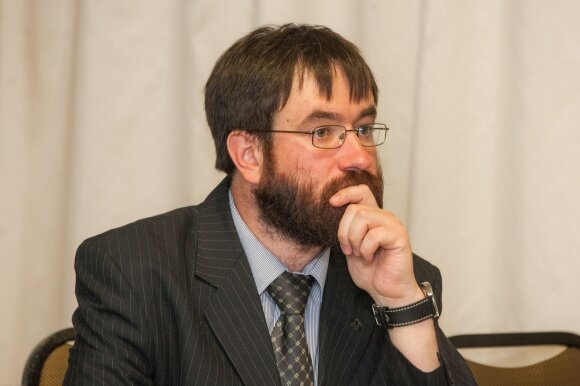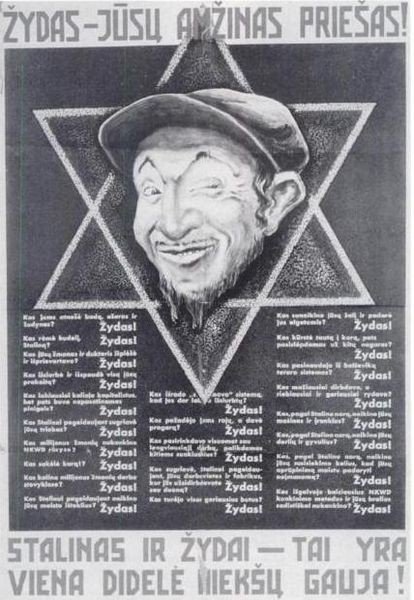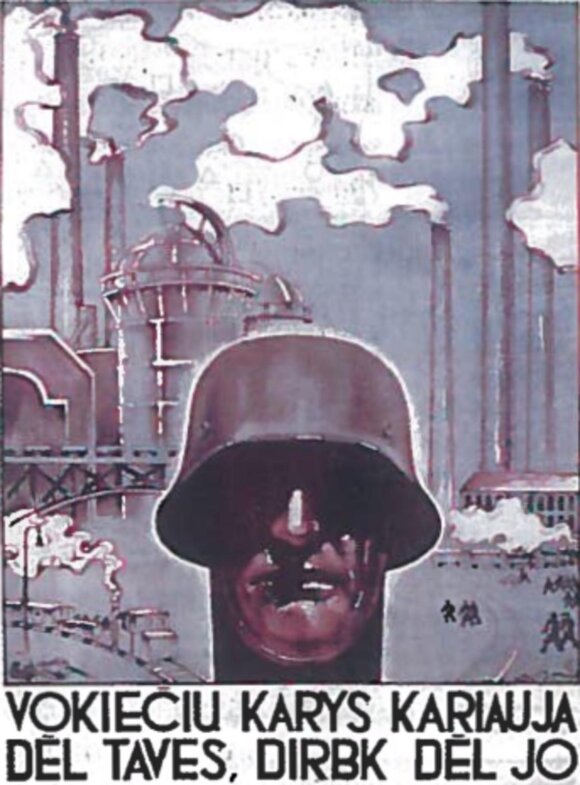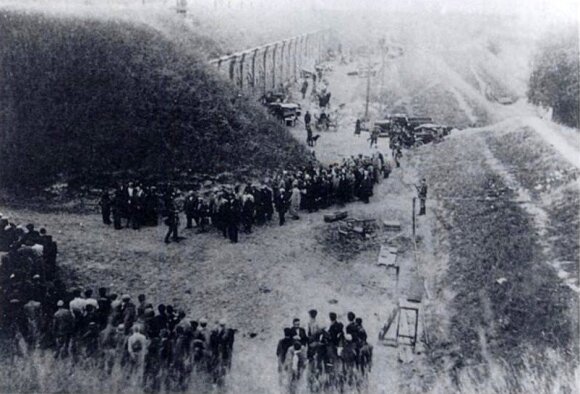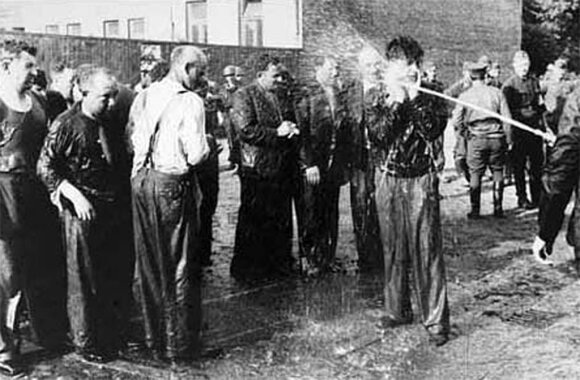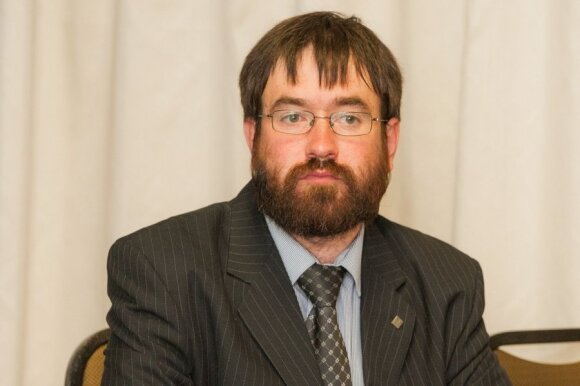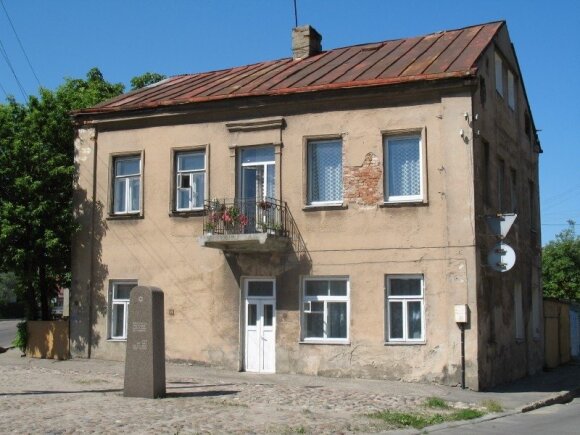The slaughter in Kaunas took place on the first day of the Nazi occupation
1941 The end of June is remembered in Kaunas as one of the darkest and most horrible stages in the history of the city. 80 years ago, on June 25, immediately after the Nazis entered Kaunas Vilijampolė pogroms led by Algirdas Klimaitis, commander of the uprising against the retreating Soviets.
About 800 Jews were killed during it, and local rabbi Zalman Osowski was beheaded and placed in the window of his house for all passers-by to see. There is also an inscription in Lithuanian announcing that such a fate awaits all Jews. The body of the tortured rabbi Vilijampolė was hung by a rope, his daughter was raped and killed together with his brother and mother.
Two days later, on June 27, extremely drastic massacres were held in the very center of Kaunas, the company “RainIn the garages (now – Miško Street).
According to surviving witness accounts, Jews forcibly driven into the yard were lashed with metal rods, throwing firefighters’ hoses down their throats, and water was poured until people lost consciousness. The survivor victims were killed by stabbing their heads with crowbars.
Most witnesses named Lithuanians as murderers. According to some witnesses, the Germans humiliated and beat the Jews, but did not kill them.
The massacre of Lietūkis garage
© Wikimedia Commons
–
The Nazis failed to provoke a massive wave of anti-Semitism
Why did the Nazi occupation in Kaunas coincide with the bloody attacks against the Jews who had lived here for a long time, what is the role of Lithuanians and Nazis in these mass executions?
Vytautas Magnus University (VDU) historian, doctor Linas Venclauskas says that by encouraging extremely drastic attacks involving Lithuanians, the Nazis had a plan to force the Jews to retreat and move the rest to the ghetto.
“It is obvious that this was an event inspired by the Nazis, because on June 27, the Nazi army had already passed through Kaunas and continued to invade,” said historian L. Venclauskas about the massacre in the yard of Lietūkis garages.
According to the scientist, the fact that the Nazis were interested in starting the massacre with the hands of the local population is evidenced by the reports of Franz Walter Stahlecker, one of the main organizers of the SS A operative group, to his leadership in Berlin.
Writing about the killed Jews in one of his reports, he mentioned that it was not possible to incite great anti-Semitic moods among Lithuanians, as expected.
“But there have been people who have been led for all sorts of reasons, and historians are trying to lay out certain lines of motivation.
Historian of Vytautas Magnus University (VMU), dr. Linas Venclauskas
–
It could have been Nazi supporters, the second motive cited by historians could have been revenge. It should not be forgotten that the first deportations took place 10 days ago, and the news about them and certain stereotypes that Jews are zealous communists was spread not only in Kaunas, but also in Lithuania.
Nazi propaganda diligently repeated that, saying that the Bolsheviks and Jews are an inseparable element and that they need to be settled with the accounts as soon as possible.
It is also possible to have a motive of jealousy, to seek to take over Jewish property, ”said Dr. VHU historian Dr. Holocaust. L. Venclauskas.
The Nazis failed to provoke a massive wave of anti-Semitism
The scholar points out that there was a great desire of the Nazis to direct Lithuanians against the Jews, and a powerful propaganda mechanism was used for this purpose.
“But we also need to remember the Nazi racist attitude here. They imagined that crossing Poland’s western borders would start a completely different world. The Nazis thought there were Slavic, Eastern lands whose inhabitants, using Nazi ideology, were at a lower stage of development. Emotionally less influential, perhaps intellectually less gifted.
Anti-Semitic poster, photo from the Lithuanian State Historical Archive.
–
They imagined that with the help of propaganda it would be enough to point the finger at their enemies, who were Jews and communists, and the locals, as in Vilijampolė or Lietūkis, would fight in the most cruel, brutal way, so the Nazis would only need to conduct these processes. Unfortunately, their assumption was not entirely correct, “said L. Venclauskas.
The historian notes that although the commander of the SS A operative group FW Stahlecker reports that mass anti-Semitic moods could not be caused among the locals, the numbers of Jews sent to him, especially from smaller Lithuanian towns, testify that Lithuanians were still used.
“Demonstration” massacres were organized in the center of Kaunas
On June 25, 1941, the first day of the Nazi occupation, the Jewish pogrom of Vilijampolė was led by rebel Algirdas Klimaitis, but it was obvious that he was instructed by FW Stahlecker, the commander of the SS A operative group. He himself acknowledged in the report that this Nazi initiative was hidden.
“It suddenly became clear that organizing a larger-scale Jewish pogrom was not quite easy at once. Here, first of all, we used the aforementioned partisan commander A. Klimaitis, who was instructed on this issue by our small front platoon in Kaunas. A. Klimaitis managed to prepare the pogrom in such a way that neither the instructions given by us nor our initiative appeared on the field.
During the first pogrom, on the night of June 25 to 26, Lithuanian partisans liquidated more than 1,000. 500 Jews, set fire to or otherwise destroyed several synagogues and burned a Jewish quarter with about 60 houses. The following nights, 2 thousand were rendered harmless in the same way. 300 Jews, “wrote FW Stahlecker, an SS officer and one of the perpetrators of the Holocaust.
It seems that by reporting to Berlin, he significantly increased the number of Jews killed in Kaunas. According to other data, about 800 Jews were killed in Vilijampolė pogrom.
A propaganda poster from the Nazi occupation
© Wikimedia Commons
–
Two days later, the massacre in the garages of Lietūkis company was even photographed, and in the center of Kaunas, a large group of curious people watched the Jews with firecrackers.
Historian L. Venclauskas calls this execution staged and used for propaganda purposes. This is why the bloody execution was attempted, the bodies of tortured people were photographed in detail.
“These are well enough documented for the massacre and then quite widespread. The photos were taken by the Nazis themselves with the intention of showing that the locals consciously recognize their enemies and treat them accordingly, “fighting their traitors, enslaved and the like.”
On the other hand, it was convenient for the Nazis to have this photo material not only to show the “awareness” of the locals. When the war turned in a direction other than that which the Nazis believed in 1941, this could become proof that they did nothing, because the Lithuanians themselves compiled the accounts.
Revenge also encouraged Lithuanians to deal with Jews
“The attitude that Lithuanians themselves have taken the Holocaust diligently is not entirely correct, because the Nazi inspirations were strong enough,” L. Venclauskas stated at Vytautas Magnus University stories.
The researcher evaluates the participation of Lithuanians in the killing of Jews by looking at the coincidence of certain events. This is the first Soviet occupation that shook Lithuanian society, Nazi propaganda, which said that Jews and Bolsheviks are one and the same. The first Lithuanian deportations to Siberia had a significant impact, which was unequivocally understood as physical destruction, the destruction of families, and not only a restriction of well-being and self-expression.
Fort VII, photo of Kaunas Fortress Fort VII Museum
–
“This is how the terrible boiler boiled, where the motive of revenge and retribution could be a sufficiently important catalyst. There is this motive of revenge in the investigations and the stories of witnesses, because one or more persons from the side of Lithuanian executioners seem to have recognized the people they associated with the Soviet government, perhaps with torture and arrests, ”said L. Venclauskas.
The scientist mentioned that in the last days of June 1941, when the occupying powers changed, prisoners were released from prisons, there was a lot of tension. So it doesn’t matter at all whether one person or another was actually involved in the Soviet repression, or just turned out to be similar.
“It simply came to our notice then. Fear and tension created their atmosphere that some decisions had to be made, and these decisions were very brutal, ”said the historian.
The massacre of Lietūkis garage
© Wikimedia Commons
–
The deportations made their own, the Lithuanian and Jewish enlightenment disappeared
Speaking about the tragic stage of the history of not only Kaunas, but also the whole country, L. Venclauskas mentions an aspect that, in his opinion, has not been properly broadcast so far.
“The deportations carried out by the Soviets also affected the Jewish elite, who could speak on behalf of their people, say that we are not Bolshevik minions, we have also suffered. But that part of that bright society, the Jewish intelligentsia, has already been repressed, deported or arrested, as well as most Lithuanian intellectuals who could say that we should not give in to Nazi propaganda, we should behave differently, “said Vytautas Magnus University historian L. Venclauskas. .
He points out that before the first Soviet occupation, when our state lived in its last days, the position was quite different, adopted by about 30 thousand. refugees from Nazi and Soviet-occupied Poland. At the time, other countries in Europe and the world refused to accept them on the grounds that they had their own problems and would not be able to take care of the refugees.
“The fact remains that those most authoritative, most understanding of the situation and able to say one word to another, both on the Lithuanian and Jewish side, had already experienced strong enough Soviet repression,” said L. Venclauskas.
Historian of Vytautas Magnus University (VMU), dr. Linas Venclauskas
–
What did the Nazis seek by promoting macabre massacres?
However, how to explain the extremely brutal, drastic attacks on local Jews by Lithuanians in the first days of the Nazi occupation, when about 800 Jews were killed during a pogrom in Vilijampolė, the rabbi was beheaded in the window of his house and tortured water, then their heads were crushed with crowbars?
Vytautas Magnus University stories, dr. L. Venclauskas believes that this cruelty seemed to have been encouraged by the Nazis themselves, and this massacre had in their plan not only the elimination of people, but also another purpose.
“It’s a psychological aspect: to scare, intimidate Jewish society and force them to retreat after the Red Army. But then the Soviets would not let anything in unless it was an active party or some other actor important to them. Like the retreating Lithuanian Jews, they were also stopped, turned around and accompanied by the phrase: “whatever you do, the homeland is in danger, the enemies are attacking, and you are trying to retreat, you have to go back and fight,” said L. Venclauskas.
–
On the other hand, according to the historian, the drastic massacre in the first days of the Nazi occupation in Kaunas could become an important motive for the Jews to move to the ghetto in Vilijampolė as soon as possible.
“It is accompanied by the message that in the face of such atrocities, such horrors, we cannot help you, protect you, you will move to a ghetto, a protected area where you are supposed to be safer. While it was clear, there was another insidious plan by the Nazis to exploit the ghetto population as unpaid labor, to eliminate elites, intellectually mature community leaders, as well as physically strong young men, through so-called cleansing campaigns, to make the Jewish community as passive as possible. and obeying orders ”, L. Venclauskas summarized the stories.
Before the establishment of the Kaunas ghetto in Vilijampolė, about 10 thousand Kaunas Jews were killed. The ghetto was home to a maximum of about 30,000 people at a time, most of whom were shot in Fort IX, others transported to various concentration camps. Only a small part, several hundred prisoners of the Kaunas ghetto, managed to escape. He joined the underground antinational resistance.
A house in Vilijampolė, next to which was the main gate to the Kaunas ghetto
© wikipedia photo
–
–
It is strictly forbidden to use the information published by DELFI on other websites, in the media or elsewhere, or to distribute our material in any form without consent, and if consent has been obtained, it is necessary to indicate DELFI as the source.
